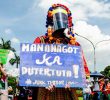Year in review
DAVAO CITY – The commemoration of anniversaries of different major calamities have become a litany of government response found to wanting and have drawn sharp criticism from victims themselves.
The snail-paced response came despite government heavy use of the social media to hype its supposed response, and its quick action to approve the modernization of its armed forces against lack of steady and dependable flow of relief and rehabilitation efforts.
On September last year to commemorate the first year anniversary of the Zamboanga siege by the armed followers fo the Moro National Liberation Front, the displaced victims remained socketed in makeshift tents and the deaths in the evacuation sites have not stopped.
Typhoon Pablo survivors who are mostly farmers have expressed their dismay during their protest commemoration here on how government responded by providing bunk houses away from their farmlands, which they claim resulted to another form of disaster for them.
The same grim face to government response is mirrored in the Visayas, during the one-year commemoration of Typhoon Yolanda (International name Haiyan) in November 8 last year.
In at least the three of these major natural and man-made calamities, survivors claim that they are still far from recovering from the impact of the disasters and describe the relief operation of the government just like the relief goods they have given; rotten.
Slow Response vis-a-vis AFP Modernization
Ironically, the modernization of the Armed Forces bragged as the administration’s accomplishment did not helped to fasten the relief operations of different calamity survivors.
It took two years for its housing agency, National Housing Authority (NHA), to construct houses for survivors of the typhoon in Compostela Valley and Davao Oriental. NHA admitted that there was shortage of 13,525 housing units for the survivors.
On December 2012, the Department of Social Welfare and Development (DSWD) said there were about 230,000 families in the two provinces that were affected by typhoon Pablo.
But so far, only 3,505 families were given housing units. Out of the 3,505 units, only 538 have been built for Davao Oriental and 2,967 in Compostela Valley.
The delayed construction of housing units in Southern Mindanao finds similar situation with what the typhoon survivors in Eastern Visayas experienced.
By August last year, the United Nations Office for the Coordination of Humanitarian Affairs (UN OCHA said there were still 40,000 homeless survivors and 160 of which died inside the evacuation centers.
Contrary to DSWD claim, the typhoon Yolanda (Haiyan) survivors’ group in Eastern Visayas, the People’s Surge, insists that there are still survivors living in tent cities located in San Jose, Tacloban City.
People’s Surge spokesperson, Dr. Eflenda Bautista said that the agency “keeps on lying to the victims that it already gave relief donations to the victims but victims from different parts of Eastern Visayas haven’t received any from the agency.”
During the first anniversary of Typhoon Yolanda, Mayor Alfredo Romualdez of Tacloban City admitted that assistance came only five months after the typhoon.
Mayor Romualdez blamed the delay in assistance to the slow recovery in the city saying that “donations were inaccessible despite overwhelming overseas support”.
Typhoon Pablo and Yolanda survivors, including Mayor Romualdez, have learned to “not expect from the national government” for its slow response.
Government priority?
On the first quarter of 2014, the Aquino administration was cited in media reports that it already completed 36 out of 91 modernization projects for its armed forces that were also stalled since the presidency of Fidel Ramos in 1995. In the last quarter, another 10 projects were completed.
Among the completed projects and purchases were helicopters, vehicles, utility trucks, coast watch requirements worth P32 billion, which reports said could help and be used during disaster relief and response.
Power of Social Media
Facebook, Twitter and other social media networks play a big role in disseminating information and mobilizing relief and volunteer operations especially during and after disasters.
According to the co-founder of TweetUpMNL Tonyo Cruz, while the advocates use social media for social good, social media also help expose lapses in relief and rehabilitation efforts of the government, including what happened in the areas of Compostela Valley, Davao Oriental, and Eastern Visayas.
In a phone interview, Cruz said that “the government can no longer hide its failure because even ordinary citizen can take photos, record videos and posted it online, unlike 20 or 30 years ago that there is still no social media.”
“Up to now, we can still see photo tweets that show that there are still people living in tents in the affected areas of Eastern Visayas,” Cruz said.
Given its potential to expose incompetence in government, Cruz admitted that there are still a lot of work to do in terms of developing the consciousness of the social media users.
Among the Internet users in the country, he said 33 per cent “are just participating if they or their relatives are affected of calamity. And majority of the population have no access to the Internet”.
He added that “social media are just a tool, so it depends on the user [on how he uses it].”
During the first year anniversary of Typhoon Yolanda, it was on the social media that exposed another failure of the the Aquino administration on its Build Back Better rehabilitation project for the typhoon victims.
Cruz said that if not for the social media, “people not living in Eastern Visayas would think that the project is good and appropriate not until another typhoon Ruby hit the island”.
“When [typhoon] Ruby hit, the cheap bunk houses were destroyed just like carton boxes,” he said.
But the case in Mindanao is different from the other two big islands.
The fewer number of Internet users in Mindanao cities compared to the other cities in Luzon and Visayas made the social media less used during disasters in the island.
According to Curz, if the mass of social media users in Davao, Cagayan de Oro, or in General Santos City would take on the plight of the typhoon Pablo victims, something might happen.
Internet users in Mindanao could initiate an online campaign in exposing the failure of the DSWD in the region which resulted to “organized confiscation” (last 2013) of relief goods stocked in the regional office.
Cruz said that the social media users could start to campaign to improve the equipment in the weather forecasting agency to deliver fast and accurate weather information.
Citing the recent incident on the reported collapse of one of the evacuation centers in Tacloban City, Cruz said that social media users may use that tool to campaign support to bills that would improve disaster preparedness.
Among the bills include the Makabayan bloc-authored Evacuation Center Act or House Bill No. 3648 that says “schools are not designed as a safe evacuation center, and cannot provide for the sanitation and health needs of thousands of evacuees.”
“It would be best to have at least one climate resilient evacuation center in every municipality if possible to shelter the population and to avoid what happened during Yolanda where evacuees died in the schools in Tacloban City,” said Bayan Muna Rep. Neri Colmenares.
According to Colmenares, “We hope that this bill will at least minimize casualties from disaster, mishaps and calamities. Hopefully, it will save lives.”
The act requires telecommunication companies to provide details of required preparation, address of evacuation areas, location, and schedule of relief operation.
“It will be clear that it is both the government and the telecom companies’ duty to send out free mobile alerts at the earliest time possible. It will also aid in the preventive evacuation, identification of safe evacuation centers and advanced information of prepositioned relief provisions for evacuees,” Colmenares said. (davaotoday.com)










